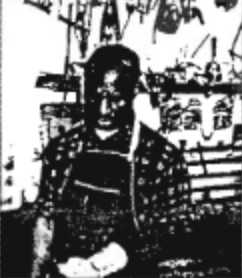
It’s great to find a shop filled with hundreds of rare and beautiful things. And that treat is even more gratifying if the shop is run by someone who can effortlessly guide you through a treasure trove of 18th and 19th century antiques.
Canute Williams, ten years in the business, does this extremely well. He discusses antiques with encyclopedic fluency. He can tell you the origin, history, style, period and value of each item in the Mercantile Gallery, sitting boldly on the corner of Fulton Street and Irving Place in Brooklyn.
”I’m completely self-taught,” Mr. Williams says as he stands next to a fine-grained oak china cabinet. One leg is bent and one elbow is propped gingerly on top of what my grandmother used to call a china closet. His right hand rests on his clean shaven head, and his left hand fills the pocket of his blue denim apron, covering a bright orange plaid shirt. “I had a hell of a lot of inquisitiveness,” he explains. “So I read books, attended shows, visited museums and spoke to knowledgeable dealers.”
Antiques were not what Mr. Williams had in mind when he opened the doors back in 1982. Then it was an appliance store which offered refrigeration and air conditioning repair services as well. But on the advice of a friend, he slowly began to turn his appliance and repair store into an antique shop, selling her furniture on consignment.
“Soon my eyes got bigger and my taste got better and, after ten years, it’s evolved into this,” he explains, making a wide sweep with his hand. “And the appliance store went the way of the dinosaur! Today, here I am a one hundred percent dealer in antiques and good used furniture.”
The Mercantile Gallery is full to the brim with ornate china closets, some displaying crystal perfume bottles and delicate floral patterned china with gilded rims, elaborately carved tables and chairs with lion claw feet, tufted velvet love seats, marquetry chests, and sleigh beds crafted during the Empire, Victorian and Renaissance periods.
An impressive gold leaf Rococo over-the-mantle mirror hangs on a wall by the door. “That’s a piece!” he says with a proud nod. “It was made around 1820. That was during the Renaissance Revival period, and it’s worth at least $20.000.” Then, with a broad smile, he adds, “There’s more upstairs in Mercantile II.”
We walk through his workshop in the rear and ascend a custom-built oak staircase. Two superbly arched, beveled glass and tiger oak doors lead into an enormous room divided by two towering columns. Fifteen tall windows encircle the room, letting in a flood of light. The windows original golden oak casings are still intact. A stained glass floral skylight bathes the room in color and graces the ceiling. The floor area between the two large columns is decorated with a design in the form of three satinwood and mahogany stars. The floor itself is made from number one red oak cut at a 45-degree angle.
The furnishings are exquisite. There is an ornate Venetian chair, for example, with an intricately designed back, a triangular-shaped seat and rams’ head feet. There are several items from Mr. Williams’ extensive Americana Collection. He particularly prizes the bronze figurines representing Africans and African-Americans, and tobacco humidors in the form of African-Americans as they appeared during the 19th century.
Naturally, such a tour and such a guide prompted a few obvious questions. I asked, “how can one tell an antique from a reproduction?” “You have to know how things were made 100 or 200 years ago.” he replies. “Certain features in a piece from the 1850s were not invented in the early 1800s. Take that mirror,” he says, pointing to the gold leaf Rococo by the door. “You notice there’s no beveling on it. That process was not invented during the 1820s. Beveling was created between 1840 and 1860, in the Victorian period.”
“You also have to pay attention to how antique furniture was constructed. Notice what kind of fasteners are used. Is the piece made with screws, nails or commercial glue? There was no Elmer’s glue back then. Glue was made originally from the gummy part of horses’ hooves. You have to teach yourself to notice details so that you don’t buy a pig-in-a-poke. If you do, you’ll either have to sell it, live with it, or eat it!”
Are antiques a good investment? “Yes!” he says. “It’s very much like buying stocks and bonds. Antiques appreciate. But, again, you have to be knowledgeable. Most people think that if something is old, it’s an antique. That’s not true. It has to be rare, documented, identifiable and desirable to more than one person. You may pay $30,000 for a piece but it may be worth $150,000 or $200,000, depending on who wants it.”
A 19th century Ansonia clock sitting on a china closet begins to chime. He mentions that it’s a house-warming gift for a friend. “That’s my way of advertising,” he says. “Someone may see it, love it and want to know where it’s from.”
Sponsoring shows is another way to advertise. Right now Canute Williams’ schedule is open. His next show is planned for February, 1994 when the Gallery will host an Americana exhibit. This Spring, the Mercantile Gallery has scheduled a show called 101 Boxes, which will feature a display of beautiful Victorian jewelry boxes. Meanwhile, the Mercantile Gallery, is open from Monday to Saturday, 12:00 to 6:00p.m. (718) 789-8729.
See ROUTES, A Guide to Black Entertainment March 1, 1992 as PDF
See a list of all archived ROUTES editions
